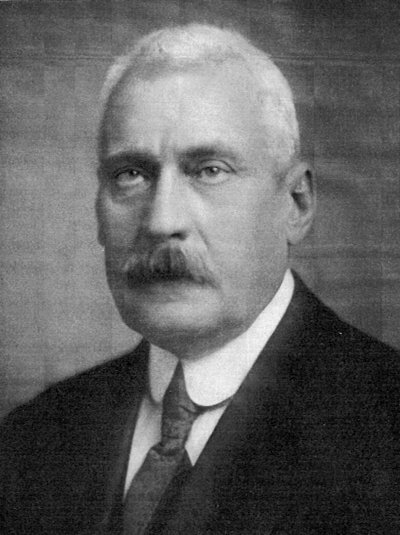Why Did Karl Bohlin Laugh?Knut Lundmark often returned to a bizarre meeting with Stockholm Professor Karl Bohlin (1860-1939) when he presented his doctoral dissertation that placed the Andromeda nebula at more than 600,000 light years - contrary to Bohlin's own measurements. In his book Astronomical Discovery I (Harrier Book Publishing, 1951), Lundmark writes about himself in third person: |
|
|
"When this doctoral dissertation was presented to Professor K Bohlin, a funny episode occurred, which at least slightly softened the gloomy mood between the two. At the beginning of the dissertation, the author made a determination of the distance to the globular clusters. This gave a rather determined support in favor of Shapley's scale, thus pointed against Charliers's hundred times less distance scale. This part Bohlin found very good and meant that it suited Charlier well to hear "a word of truth". When the writer later came to Charlier, he could not appreciate the section on the spherical stars, but Bohlin was told how bad it was for his results. A third authority, who went through the dissertation, was not so happy with some conclusions, but at least thought it was excellent that Bohlin and Charlier got to hear how these conclusions reflected upon their own results concerning nebulae and stellar clusters. But we return to Bohlin. He began to darken already in the criticism of his direct distance determination to the Andromeda nebula. When Lundmark asked if it was possible that some systemic influences played a role, Bohlin said emphatically: "I want to draw attention to the licentiate that my measurements were made absolutely unconditional and with extreme accuracy." Of course, so also believed the licentiate, who in turn said he enjoyed all the admiration for the enormous work that Bohlin had made for his parallax measurement. No less than about 40,000 micrometer settings had been made on the photographic material. It would also take several years before Lundmark was able to obtain the probably definitive explanation of what had influenced the measurements in a systematic manner and brought about the wrong result that the Andromeda nebula would be 19 light years close, while in reality the distance is well over one million light years. The review continued! Lundmark had made a series of limity calculations, which in different ways determined a number of limit values, so that no nebulae could be located closer to us than these values. These limit values grew inevitably. In the end, the final result was announced, that closer to us than 20,000 light years were impossible. Now the great astronomer was very dissatisfied. Then came the two new methods, the use of the exploding suns and the brightest of the common suns in both systems. The distance to the Andromeda nebulae must be more than half a million light years, and that to the spiral in the constellation of the Triangle more thand one and a half million light years. Nor did this Bohlin any happier. Yes, the discussion continued. The author must of course stay on the defensive. Finally, the spotlights were also focused on the nebulae close to the South pole of the sky, the two Magellanic clouds, which in one way or another must be related to both the Milky Way and the spirals, although the clouds in question did not show any spiral structure. Lundmark had come to the conclusion that it was not necessary that all anagalctic nebulae were spiralshaped. He meant that the two Magellanic clouds were also systems like the Milky Way, but perhaps they were of a degenerate version, or that they even just were beginning to form spirals. He had now discovered a third Magellanic cloud, an object previously considered a spiral, but although it belonged to this class it at least showed an irregular structure and, above all, had a very similar resemblance to the greater of the Magellanic clouds . When the great astronomer came to a comparison, made in an image in the dissertation between the great Cloud and the former spiral-considered object, he burst into a bouncing laughter. Lundmark does not know even at this very moment, why Bohlin laughed so gladly. Somewhat, albeit not entirely, it made the atmosphere easier. But at the dissertation, Bohlin never believed and would never do it during his remaining life. " |
Andromedagalaxen |
|
Even in his masterpiece New heavens (1943), Knut Lundmark discuss Bohlin's results from 1907, that the distance to the system in Andromeda would only be 19 light years. Everything pointed at Bohlin´s use of the small 6-inch telescope in Stockholm was totally unfitted for that kind of measurements and that there were built-in flawed sources in the telescope, especially in the RA-angle. Karl Bohlin appears to have turned into a kufic and tragic person, which, according to some, run the Stockholm observatory almost tyrannical, and stood in the way of the new astronomy. When Bertil Lindblad became professor and Bohlin´s successor, Lindblad immediately put the new Saltsjöbads observatory on the map. Bohlin died in 1939. In spite of his previous relations with Bohlin (who strongly opposed Lundmark's appointment as professor in Lund), Lundmark wrote a honette summing up of his life in ASTB's Cassiopeia 1940s book, meaning that Bohlin was "quite a isolated nature" and difficult to come close to. In an article in the Malmö morning paper Sydsvenskan 8.11.1943 Lundmark returns to Bohlin and their discussion 25 years earlier. He still didn´t understand why Bohlin laughed in 1918.
|
|




_thumb.jpg)
